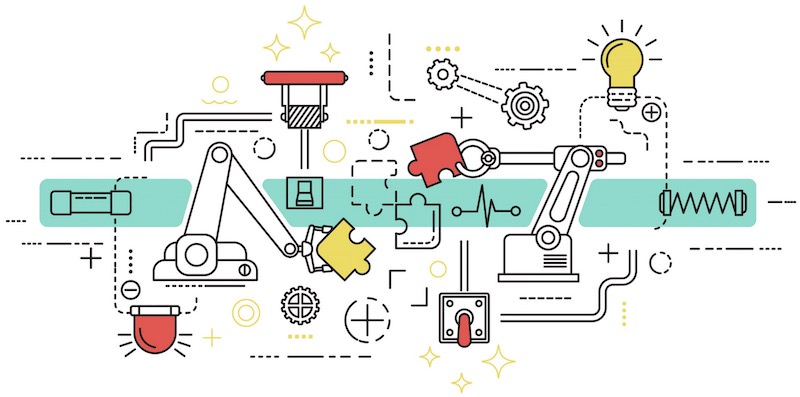Web design is a long process for anyone, web design agencies included. Whether your team gets stuck in production bottlenecks or overestimates just how much time a project actually takes, chances are there’s room for improvement. And your team isn’t the only one: a recent report from the Bureau of Labor Statistics found that non-farm labor productivity fell 4.6% in the second quarter of 2022, while hours worked increased by 2.6%.
There’s clearly a disconnect: we’re putting more hours in but not getting as much done. For the agencies, this means going back to the drawing board and determining where they can improve their productivity habits.
Increased productivity offers agencies tons of benefits, from better customer and employee experience to higher profit margins and agency scaleability. Here are a few ways you can improve your agency’s productivity and scale up your business.
1. Automate Repetitive Tasks


Time gets lost in tedious but often necessary tasks. While important, things like updating social media and reporting data cut into your workflow. Thankfully, there are tons of automated tools to assist with most of these tasks.
Instead of copy-pasting data into slides, why not use an automated reporting tool? Instead of needing to stop what you’re doing to publish social media posts every day, why not schedule them all in advance using something like Sprout Social or Hootsuite?


For agencies that maintain multiple websites, there are platforms that use automation to allow you to implement changes on hundreds of websites at once instead of manually editing each.
Tools like these do require some up-front investment to get set up, but the long-term benefits to your productivity are usually well worth it.
2. Streamline Communication Processes
One way to boost communication is to have tools that enable you to do so. For example, consider using a platform that lets clients input feedback directly on the site, making it easier for your designers to implement changes faster.


You’ll be able to modify the website in a lot less time since the requests are within the context of the site, making it clear to both sides what is required. This is much faster than email threads or long-winded meetings, where feedback is likely to get lost.
Consider creating a process for managing client feedback as well. Having all the communication stored in email is not efficient, lacks historical tracking and monitoring, and most importantly, doesn’t enable sharing the support load among several employees.
Keeping client feedback in one place allows employees and clients to better track requests and creates a clear system for implementing feedback.


3. Prioritize by Using Data
If you’re not tracking project data, you need to be. It’s no use working on projects that won’t bring in new business or help you scale, so why waste time on them?
Agencies can use the Pareto Principle, or the 80-20 rule, to determine which types of projects are most important to their bottom line. The Pareto Principle states that 80% of outcomes come from 20% of causes or that companies should prioritize the 20% of their to-do list that will result in 80% of the best results.
This rule gives you an easy model to see what’s working and what isn’t. Whether it be internal changes, choosing the right types of clients or projects, or building your own advertising campaigns, you need data to better understand how to prioritize the work that helps your agency scale.


Another way to use data in client management is to track project hours. Once you have the data on how long a project takes and how much time is spent supporting a client, you can start to calculate how profitable they are for you.
You can gain a better understanding of which services provide a better ROI versus those that eat away at your staff’s time. Having this kind of data can help you better understand your business, increase your productivity, and help you scale.
There are different tools that can help you gain insights into your business. Many of the existing tools an agency uses to provide some level of analytics. You might even want to consider consolidating analytical data into a single business intelligence tool to combine separate data sources into single reports.
Use Tools that Help You Scale
The key to true productivity is knowing which tools can assist your agency the best. Finding and implementing those tools is not always an easy process and often requires a lot of work upfront. But assessing your agency’s productivity and finding room for improvement will serve to benefit the company as a whole.


Multiple tools are available to help you automate, collaborate, and gather data. Taking advantage of them will help you save time, build more, and optimize your business. These tools ultimately let you get back to work doing what you do best – creating excellent websites for your clients.
About the author of this post:
This guest post is written by Itai Sadan. Itai is the CEO and Co-Founder of Duda, the leading website-building platform for web professionals, agencies, and SaaS platforms that serve SMBs. Under Itai’s leadership, Duda rapidly expanded its professional website builder product suite with an emphasis on empowering web professionals with cutting-edge tools to help them create beautiful conversion-driving websites at scale. To date, Duda has a combined $100 million in funding and hosts more than a million active websites that have been built by over 18,000 customers globally.
Itai’s expertise in the online presence and web design space has been cited by USA Today, Nasdaq, CMSWire, Entrepreneur, Business Journals, Forbes, Inc., TechCrunch, HuffPost, Search Engine Land, and more. He is a regular speaker at industry events hosted by such organizations as BIA Kelsey, Constant Contact, Local Search Association, CloudFest, SaaStr, and SIINDA. Itai has a BSc in Computer Science and Mathematics from the University of Ben Gurion in Israel.






